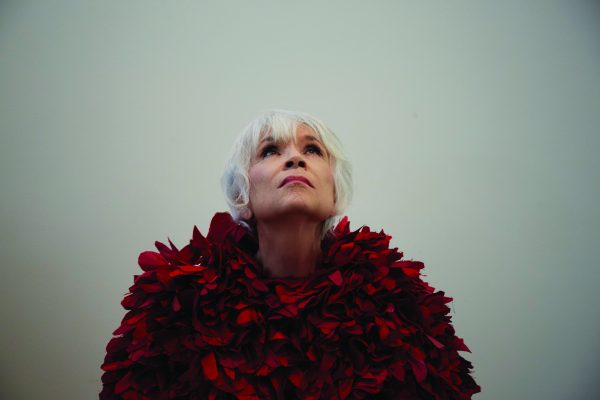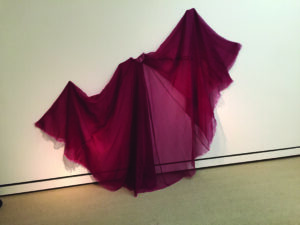
SHAPE: Luzene Hill, an EBCI tribal member, is shown as a cape begins to rise at the beginning of her shapeshifting action for her latest art installation entitled “Enate” which is part of a larger exhibit entitled “Connecting Lines” and addresses the serious issue of violence against Native American women as well as tribal sovereignty issues. (Photos courtesy of Luzene Hill)
By SCOTT MCKIE B.P.
ONE FEATHER STAFF
Luzene Hill, an EBCI tribal member, is known worldwide for her interesting and thought-provoking visual arts. Entitled “Enate”, her new installation located at the Portland Art Museum in Portland, Ore., is part of a larger exhibit entitled “Connecting Lines” and addresses the serious issue of violence against Native American women as well as tribal sovereignty issues.
“’Enate’ is a multi-media installation addressing the issue of violence against women, specifically Native American women,” said Hill. “I use material volume as a device to present numbers and statistics. This work includes two silk capes, cochineal, and a video of my shapeshifting action wearing the capes.”
She started working on her installation in September 2016 when she was invited to participate in a two-person show, “Connecting Lines”, along with Brenda Mallory, a Cherokee Nation citizen.
“Last summer, I was experimenting with cochineal as a pigment and around the same time saw images of 5,000-year-old goddess figures from the coastal region of Ecuador,” Hill commented. “I cut silhouettes, based on those figures, out of silk taffeta. The first step was dyeing strips of fabric, using various mordants and solution ratios to get a range of hues, from scarlet to crimson. Then, I began cutting out the 6,956 silhouettes.”

ARTIST: Luzene Hill, an EBCI tribal member, is known worldwide for her interesting and thought-provoking visual arts. (Photos courtesy of Luzene Hill)
Hill had a reason for making that many silhouettes.
“My goal is to draw attention to the great number of Native women who are sexually assaulted, displaying these statistics through material volume,” she noted. “Just reading a number, like 6,956, doesn’t have the impact that seeing the number in a mass of material. Six thousand nine hundred and fifty-six (6,956) is the average number of Native women assaulted each year, but only 16 percent of sexual assaults are ever reported. It’s the least reported violent crime. This number, as material volume, is presented in the outer cape, which is full length and covered with the female figures.”
Once the silhouettes were completed, “The third step for the outer cape was to group the figures into clusters of three, tacked in the center, which created a feather-like triangle. These I sewed onto a heavy silk full-length cape. Cochineal dye comes from small insects that live on cacti in Central and South America, which were cultivated and used extensively for painting and dyeing textiles prior to Spanish contact. When the Spanish saw the intense red hues, they plundered and hoarded it, and cochineal became their second most important export, after silver.”
View her transformation: https://www.youtube.com/watch?v=XuqWEiBwMLs
Part of her art for the installations is not just visual, but active. “My other goal for ‘Enate’ is to show, through my shapeshifting action, empowerment and sovereignty. I begin the action on the floor covered with the cape, which looks shapeless, amorphous. I begin to animate it and rise up as it becomes a moving entity. Then, I emerge, a woman enveloped in a mantle of empowerment and protection. The cape lifts up and I’m left wearing a gossamer inner cape, symbolically a layer of cochineal protection. The intense red color in cochineal comes from carminic acid, found in the female bugs and is a deterrent against predators. The 6,956 survivors are transformed into goddesses, imbued with cochineal protection and empowered by their unity.”
On “Connecting Lines”, Hill was able to work with other Cherokee women in addition to Mallory, partnerships that she said evolved gradually as the project moved along. “We chose Ashley Holland, Cherokee Nation, to write the essay, since she’s a scholar and is familiar with both our work. It was important to us that the title of the show, and titles of our two installations, be in syllabary as an expression of Cherokee culture and language sovereignty. My cousin, Laura Pinnix, had translated a title for my first large installation, ‘The Pilgrimage Ribbon’. She agreed and generously gave us her time and expertise for the translations. The other Cherokee woman is my daughter, Samantha Page McDaniel, who is a costume designer, taught to sew by my grandmother.”
Hill added, “The fabric cutout cluster idea came from a capelet, featuring a flower motif, which my grandmother made for me when I was in college. Sam’s involvement and my grandmother’s influence is a personal expression of matrilineal bonds. ‘Enate’ is a synonym for matriline, connections through the mother, and the overall concept for this work is to draw strength through matrilineal culture.”

CAPE: The inner cape is shown in this photo attached to the wall after Hill metaphorically disappears into
the wall.
A 2016 NACF (Native Arts and Cultures Foundation) Fellow, Hill never slows down with her artwork, and she’s already planning her next work. “I have a new installation planned, ‘Traces and Wounds’, that will use cochineal and principles of the Inka khipu counting system to address the issue of violence against Native American women. As soon as I return from the Native Arts and Cultures Fellowship convening in June, I will begin that fabrication. I’m currently making new drawings, exploring ways to print with hand held rollers, methods used by women in pre-contact societies, and continuing my research of matrilineal culture in the Americas.”
“Connecting Lines” will show at the Portland Art Museum now through Oct. 29. For more information, visit www.portlandartmuseum.org or call (503) 226-2811 or (503) 276-4249. The Museum is located at 1219 SW Avenue in Portland, Ore. and is open six days a week (closed on Monday) with the following hours: Tues. 10am – 5pm, Wed. 10am – 5pm, Thurs. 10am – 8pm, Fri. 10am – 8pm, Sat. 10am – 5pm, and Sun. 10am – 5pm.


